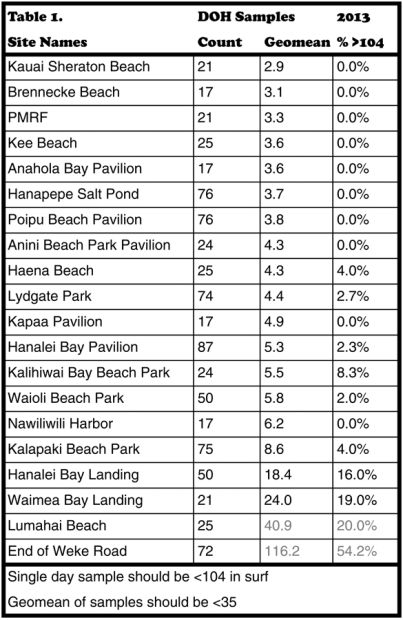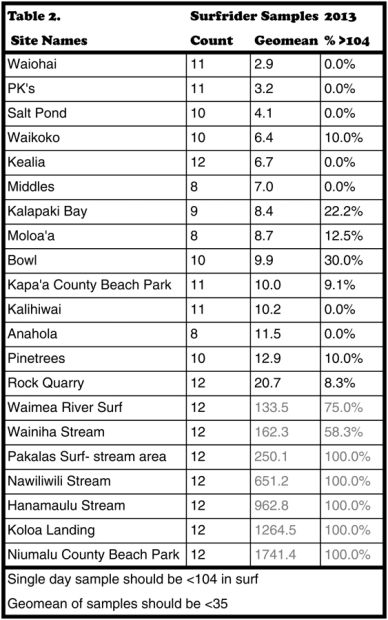In 2013, Kauai’s ocean beaches and surfbreaks were mostly clean, but some were definitely not. Our streams, with run-off and ground water contamination, are often polluted. This is a summary of water quality for Kauai.
Water quality monitoring data is collected weekly by the Hawaii Department of Health at ocean beaches around the island and monthly samples are collected by the Blue Water Task Force of the Surfrider Foundation Kauai Chapter at surfbreaks and streams around the island.
Most of the time the waters are clean. The exception is when heavy rains cause runoff from the land to turn the waters brown. The DOH then usually issues a “Brown Water Advisory” to stay out because the runoff can contain sewage and other pollutants.
During water quality monitoring, water samples are collected and the bacteria Enterococcus, an indicator of feces contamination, are cultured and counted in a 100 ml water sample. In a single sample the count must not exceed 104 bacteria per 100 ml. The geometric mean (average) of five samples should not be more than 35 bacteria per 100 ml., but what is reported here are geometric means for the entire year 2013.
The DOH data for 2013 was collected by DOH staff (and Surfrider field assistants) in about mid-calf deep water on the beaches. A total of 20 different sites were sampled over the course of 2012; eight sites were collected on at least a weekly basis over the course of the full year, another 12 for half a year.
DOH data for frequently collected sites is presented in Table 1. The sites are listed from cleanest on down to most often polluted. Note that 10 of the 20 sites are clean and never exceeded the single sample “polluted” standard and most are polluted less than 10 percent of the times.
The Hanalei River mouth at Weke Road was polluted 54.2 percent of the time and Lumahai Beach by the river was polluted 20 percent of the time. Only those two sites had a geometric mean greater than 35 colonies per 100 ml. This suggests that pollution is mainly coming from river water.
The Hanalei River site has been posted for years with two signs warning of possible contamination by sewage. Note that not all of the county parks on Kauai are tested regularly (e.g. Niumalu) and neither are popular places like Koloa Landing and Pakalas. The most recent values from the DOH are posted on their website at http://emdweb.doh.hawaii.gov/CleanWaterBranch/WaterQualityData/default.aspx
Table 2 lists the offshore surfbreaks and streams that the Surfrider Foundation Kauai Chapter samples on a monthly basis and tests for Enterococcus bacteria; the same test as used by DOH. All sites are different from the DOH sites. The sites are listed from cleanest down to most commonly polluted.
The most important thing to note is that most surf sites had very low geometric means, i.e. they were really clean. Since they were sampled only monthly, even one rainfall event could account for a 10 percent exceedance.
The ones of most concern are those where they were polluted all of the time, including Waikomo Stream at Koloa Landing, Nawiliwili Stream in Kalapaki Bay, Hanamaulu Stream, and Niumalu Beach Park near Puali Stream and the Huleia River. Pakalas surfbreak, off the stream area, also has a high geomean count.
The worst sites are by streams and rivers which carry pollutants from the land into the ocean.
The most recent values for Surfrider Foundation Kauai Chapter samples taken on the second Saturday of each month can be found at http://kauai.surfrider.org/what-we-do/blue-water-task-force/
• Dr. Carl J. Berg is head of the Blue Water Task Force, The Surfrider Foundation — Kauai Chapter






